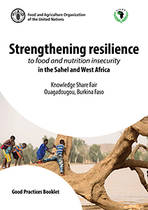
Good practices and resilience
Knowledge sharing and capitalization of good practices have a key role to play in building the resilience of agriculture-based livelihoods. Considerable experience is being gained across sectors and ad-hoc solutions addressing shocks and crises are being found in many different contexts. A fair amount of these experiences are already being documented. However, the resilience-related knowledge gained needs to be systematically analysed, documented and shared so that development organizations and actors understand what works well and why and thus replicate and upscale identified good and promising practices in order to inform policies adequately.
Latest Good Practices





“Good”, “best” and “promising” practices
When identifying and documenting an experience, it is important to understand the different states of a practice, regarding the level of evidence and its replicability potential. And to recognize that not all experiences can be qualified as good practices.
A good practice can be defined as follows:
More
A good practice is not only a practice that is good, but one that has been proven to work well and produce good results. It has been tested and validated through its various replications and is therefore recommended as a model and deserves to be shared, so that a greater number of people can adopt it.
"Best" vs "good" practices:
More
The term “best practice” is often used; however, some will prefer to use “good practice” as “best practice” may imply that no further improvements are possible to the practice. It is indeed debatable whether there is a single ‘best’ approach knowing that approaches are constantly evolving and being updated.
For a practice to be considered as a “good practice”, it needs to be supported by a series of evidence obtained through data gathering and several replications. In some cases, a practice has the potential to become a “good practice” but cannot be yet qualified as one because of a lack of evidence and/or replications. In this case, it can be considered a “promising practice”.
A promising practice can be defined as follows:
More
A promising practice has demonstrated a high degree of success in its single setting, and the possibility of replication in the same setting is guaranteed. It has generated some quantitative data showing positive outcomes over a period of time. A promising practice has the potential to become a good practice, but it doesn’t have enough research or has yet to be replicated to support wider adoption or upscaling. As such, a promising practice incorporates a process of continuous learning and improvement.

